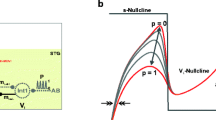Summary
The salivary burster (SB) is an autoactive motoneuron to the salivary duct of the terrestrial slugLimax maximus. The SB is electrically coupled to protractor motoneurons and inhibited by the metacerebral giant cell. During feeding these synaptic inputs cause SB activity to be phase-locked to the protraction-retraction cycle. The SB can be used as a clear and reliable monitor of feeding motorprogram activation.
Similar content being viewed by others
References
Audesirk, G., Strumwasser, F.: Circadian rhythm of neuron R15 ofAplysia californica: in vivo photoentrainment. Proc. nat. Acad. Sci. (Wash.)72, 2408–2412 (1975)
Barker, J.L., Gainer, H.: Studies on bursting pacemaker potential activity in molluscan neurons. I. Membrane properties and ionic contributions. Brain Res.84, 461–477 (1975)
Beiswanger, C., Jacklet, J.: In vitro tests for a circadian rhythm in the electrical activity of a single neuron inAplysia californica. J. comp. Physiol.103, 19–37 (1975)
Carpenter, D.O.: Ionic mechanisms and models of endogenous discharge ofAplysia neurons. In: Neurobiology of invertebrates mechanisms of rhythm regulation (ed. J. Salánki), pp. 59–80. Budapest: Akadémiai Kiadó 1973
Chang, J.J., Gelperin, A., Johnson, F.H.: Intracellularly injected aequorin detects transmembrane calcium flux during action potentials in an identified neuron from the terrestrial slug,Limax maximus. Brain Res.77, 431–442 (1974)
Dowling, J.E., Ripps, H.: Effects of magnesium on horizontal cell activity in the skate retina. Nature (Lond.)242, 101–103 (1973)
Gainer, H.: Electrophysiological behavior of an endogenously active neurosecretory cell. Brain Res.39, 403–418 (1972)
Gelperin, A.: An identified serotonergic input has reciprocal effects on two electrically coupled motoneurons in the terrestrial slug,Limax maximus. Biol. Bull.149, 426–427 (1975)
Gelperin, A., Forsythe, D.: Neuroethological studies of learning in mollusks. In: Simpler networks: An approach to patterned behavior and its foundations (ed. J.C. Fentress), Chap. 16. Sunderland, Mass: Sinauer Associates 1976
Gerschenfeld, H.M., Paupardin-Tritsch, D.: Ionic mechanisms and receptor properties underlying the responses of molluscan neurons to 5-hydroxytryptamine. J. Physiol. (Lond.)243, 427–454 (1974)
Getting, P.A., Willows, A.O.D.: Modification of neuron properties by electrotonic synapses. II. Burst formation by electrotonic synapses. J. Neurophysiol.37, 858–868 (1974)
Gillette, R., Davis, W.J.: Control of feeding by the metacerebral giant neuron ofPleurobranchaea. Neuroscience Abstracts, p. 571. Society for Neuroscience, 5th Annual Meeting, 1975
Graubard, K.: Synaptic transmission without action potentials. Neuroscience Abstracts, p. 652. Society for Neuroscience, 5th Annual Meeting, 1975
Jahan-Parwar, B., Smith, M., Von Baumgarten, R.: Activation of neurosecretory cells inAplysia by osphradial stimulation. Amer. J. Physiol.216, 1246–1257 (1969)
Junge, D., Stephens, C.L.: Cyclic variations in potassium conductance in a bursting neuron inAplysia. J. Physiol. (Lond.)235, 151–181 (1973)
Kandel, E.R.: An invertebrate system for the cellular analysis of simple behaviors and their modifications. In: The neurosciences: Third study program (eds. F.O. Schmitt, F.G. Worden). Cambridge: MIT Press 1974
Kater, S.B.: Feeding inHelisoma trivolvis: The morphological and physiological bases of a fixed action pattern. Amer. Zool.14, 1017–1036 (1974)
Kater, S.B., Kaneko, C.R.S.: An endogenously bursting neuron in the gastropod mollusc,Helisoma trivolvis: characterization of activity in vivo. J. comp. Physiol.79, 1–14 (1972)
Kristan, W.B.: Neural control of swimming in the leech. Amer. Zool.14, 991–1001 (1974)
Kupfermann, I., Weiss, K.: Water regulation by a presumptive hormone contained in identified neurosecretory cell R15 ofAplysia. J. gen. Physiol.67, 113–123 (1976)
Osborne, N.N., Cottrell, G.A.: Distribution of biogenic amines in the slug,Limax maximus. Z. Zellforsch.112, 15–30 (1971)
Pearson, K.G., Fourtner, C.R.: Nonspiking interneurons in walking system of the cockroach. J. Neurophysiol.38, 33–52 (1975)
Pitman, R.M., Tweedle, C.D., Cohen, M.J.: Branching of central neurons: intracellular cobalt injection for light and electron microscopy. Science176, 412–414 (1972)
Prior, D.J., Fuller, P.M.: The use of a cobalt iontophoresis technique for identification of the mesencephalic trigeminal nucleus. Brain Res.64, 472–475 (1973)
Selverston, A.I.: Structural and functional basis of motor pattern generation in the stomatogastric ganglion of the lobster. Amer. Zool.14, 957–972 (1974)
Senseman, D., Gelperin, A.: Comparative aspects of the morphology and physiology of a single identifiable neuron inHelix aspersa, Limax maximus andAriolimax californica. Malacol. Rev.7, 51–52 (1974)
Spira, H., Bennett, M.V.L.: Synaptic control of electrotonic coupling between neurons. Brain Res.37, 294–300 (1972)
Stinnakre, J., Tauc, L.: Central neuronal response to the activation of osmoreceptors in the osphradium ofAplysia. J. exp. Biol.51, 347–361 (1969)
Strumwasser, F.: Neural and humoral factors in the temporal organization of behavior. Physiologist16, 9–42 (1973)
Thompson, S.H., Smith, S.J.: Depolarizing afterpotentials and burst production in molluscan pacemaker neurons. J. Neurophysiol.39, 153–161 (1976)
Weiss, K.R., Cohen, J., Kupfermann, I.: Potentiation of muscle contraction: A possible modulatory function of an identified serotonergic cell inAplysia. Brain Res.99, 381–386 (1975)
Author information
Authors and Affiliations
Additional information
We thank Dr. Joseph Jin Chang for invaluable assistance with some of this work. Support was provided by NSF grant BMS74-15217 to D.J.P., NSF grant BMS74-03572 to A.G., and a grant from the Spencer Foundation.
Rights and permissions
About this article
Cite this article
Prior, D.J., Gelperin, A. Autoactive molluscan neuron: Reflex function and synaptic modulation during feeding in the terrestrial slug,Limax maximus . J. Comp. Physiol. 114, 217–232 (1977). https://doi.org/10.1007/BF00657320
Received:
Issue Date:
DOI: https://doi.org/10.1007/BF00657320




